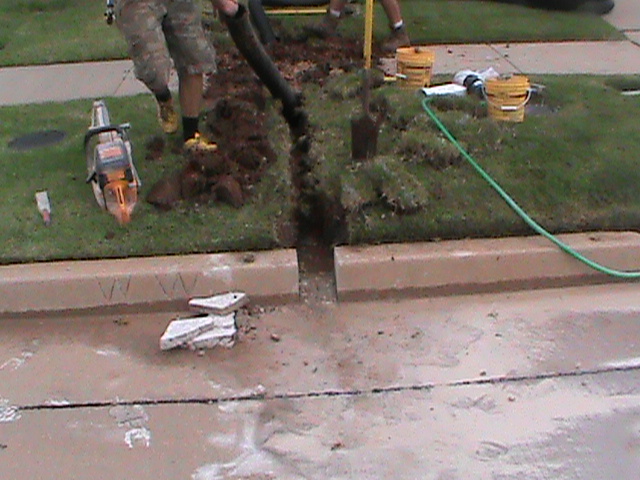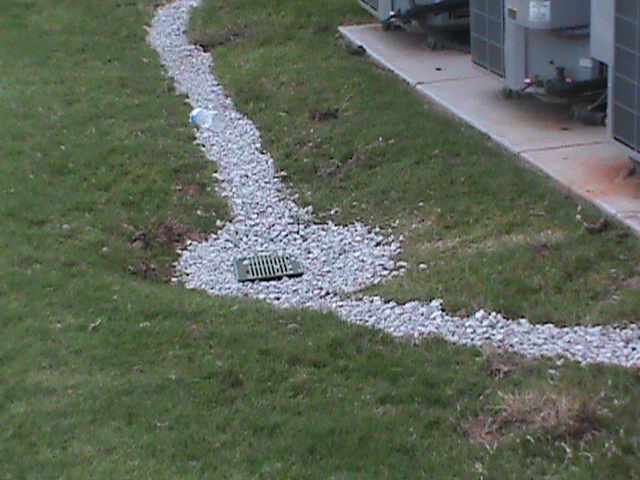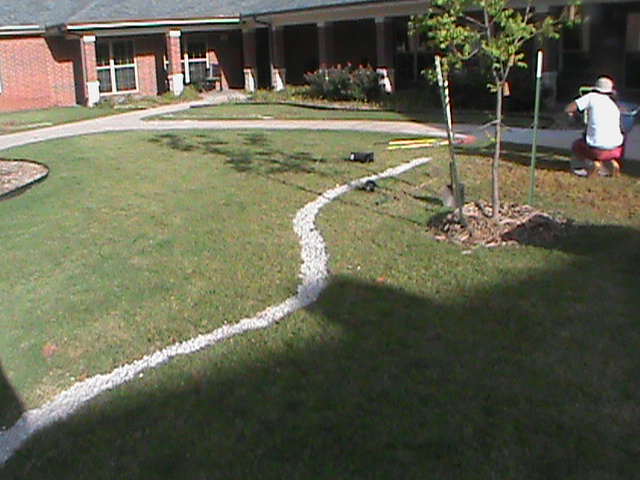FRENCH DRAINS PROTECT FOUNDATIONS
Standing water can cause many types of property damage ranging from foundation problems to cracked sidewalks and dead plants and shrubs. If you have need of French Drain or Surface Drain, give CMG a call. We provide free estimates for all of central Oklahoma.

- French Drain With Colored Gravel in Oklahoma City
Some Drainage Systems are complex and incorporate several types of drains. Most Drainage Systems , however are basic and require just one type of Drain. CMG installs a variety of drains to solve a variety of problems. French Drains, Surface Drains, and Channel Drains are most commonly used. If you live in Edmond and need a Channel Drain installed across your driveway, or if you live in Norman and need a French Drain in your backyard, or if you live in Oklahoma City and need a Surface drain installed next to your sidewalk, give CMG a call. 405-226-0629
The most common Drain that we install is the French Drain. This is because the French Drain is versatile. It can handle Surface Water Problems or Underground Water Problems (sub-surface). A huge mistake that many people make is assuming that water gets to a Problem Drainage Area by flowing over the surface only. For example, if water is flowing down hill underground toward your home's foundation, the only way to stop or intercept it is with a French Drain. Water can flow laterally into a perforated French Drain Pipe. It is then diverted away from the Problem Drainage Area to an Exit Point.
A French Drain is completely different from a Surface Drain. A basic French Drain consists of a Perforated Drain Pipe in the bottom of a trench. A Trench Liner is sometimes used depending on the Drainage System Design and the type of soil. The Drain Pipe should have a neoprene sock around the Perforated Drain Pipe. This is to ensure that the Drain Pipe does not become clogged. A trench is dug that is slightly wider than the French Drain Pipe that is being used. There are several sizes of French Drain Pipe. Three Inch, Four Inch, and Six Inch are the most common sizes of French drain Pipe. The dirt that is taken out to make the trench is hauled away. It is replaced by some type of small stone or gravel depending on what is desired or available. I prefer crushed 1 inch lime stone. It is the most economical option in my area. Pea Gravel or some other type of small stone can work just as well. The lime-stone or gravel is placed in the trench on top of the perforated Drain Pipe and filled all the way to the surface (ground level). In some cases where the French Drain needs to be deep or is being placed in sandy soil, a special trench liner must be placed in the trench before the perforated Drain Pipe or the Gravel are installed. This helps maintain the integrity of the trench over time. It also increases the cost of the French Drain and the amount of time to install it. I install a trench liner in a French Drain about 20% of the time. Most of the time a liner in not needed.

- Pipe running to street form French Drain in back yard.
A French Drain is designed to handle a large volume of water and cover a large area. The Drain is anyplace the trench goes. It has many applications and can be used in many situations. It can be installed by itself or incorporated into a Drainage System with Surface Drains or Gutter Down-Spouts connected to it.
The main downfall of a French Drain is that they, for the most part aren't very pretty. They don't look very nice in a yard once they are completed.
Depending on the area the French Drain is installed and the type of grass around the French Drain, will dictate whether grass grows over the lime stone. Grass can grow up and through the gravel in the French Drain over time eventually covering the gravel. This is OK. It won't have a measurable effect on the performance of the French Drain. In some cases thick grass growing up through the French Drain will create a natural "Thatch" filter. This makes the French Drain invisible. The trick is to allow the grass to grow over the French Drain Gravel without covering it up with dirt. Grasses such as Bermuda which grow well in the sun will put out runners and new roots and will grow up and through the French Drain. This will not affect the performance of the French Drain. The problem is that some times depending on the type of soil involved, it may take a long time to completely cover up the French Drain. Sprinkling grass seed down in the gravel will speed up the process.
DON'T COVER THE GRAVEL IN THE FRENCH DRAIN WITH DIRT. THE FRENCH DRAIN WON'T WORK IF THE TRENCH IS CLOGGED WITH DIRT. DON'T EVEN INSTALL IT IF YOU ARE GOING TO COVER IT UP WITH DIRT.

- Installing a Curb Outlet for a French Drain in Oklahoma City
If you install a French Drain in a sunny area, you can:
A. Leave the French Drain as-is and allow grass to grow over it in time.
B. Add grass seed directly to the French Drain gravel with (Light Hand Watering) to speed the growth process
C. Leave the French Drain as-is but decorate it with stepping stones and landscaping rocks ( leaving large cracks between stones to allow water to get into the French Drain,
2
If you install a French Drain in a shady area you can:
A. Leave the French Drain as-is, it will work well and look as it did for many years.
B. Leave the French Drain as-is, but decorate it with stepping stones or landscaping rocks. Many French Drains are hidden under rock walk ways.

- French Drain in Oklahoma City
IF YOU NEED WATER DRAINED AWAY FROM YOUR HOME OR BUSINESS CALL CMG. 405-226-0629 CMG Sprinklers and Drains installs all types of Drainage Systems and French Drains.


No comments:
Post a Comment